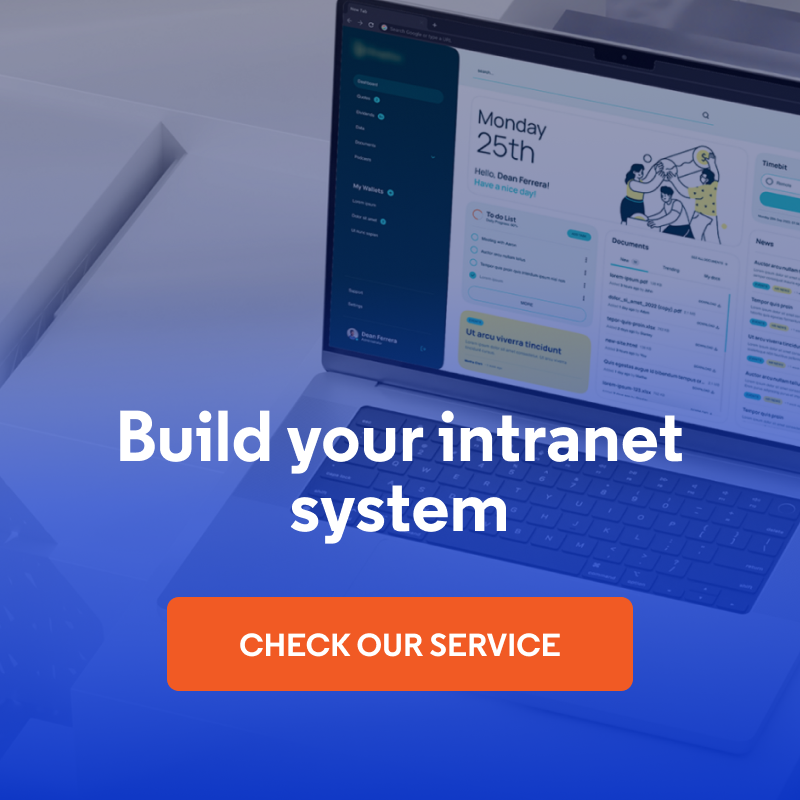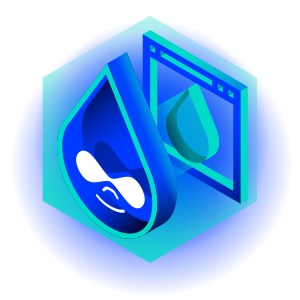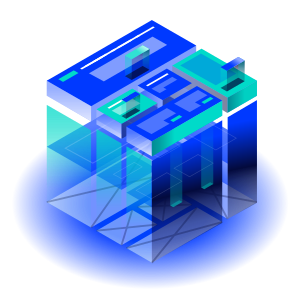
HR Intranet. How Can the Right System Support the Human Resources Department?
The HR department is responsible for recruitment, employee development, and leave management. At the same time, HR professionals spend most of their time on repetitive administrative tasks. A modern intranet system can automate routine processes and give employees the tools to manage their own affairs. How exactly does the intranet software support the work of the HR teams?
In this article:
- 1. Process automation through electronic forms
- 2. Employee profile and self-service
- 3. Leave and absence management
- 4. Internal recruitment
- 5. HR knowledge base
- 6. Onboarding new employees
- 7. Employee development and training
- Summary - benefits of a company intranet for HR
1. Process automation through electronic forms
The human resources department receives dozens of requests every day: vacation requests, business trips, training, problem reports, and satisfaction surveys. Traditional management of these processes using paper forms or chaotic emails is a real headache—documents get lost, it is unclear what stage a request is at, and employees bombard HR staff with questions about the status of their cases. Electronic forms on the company intranet portal are a revolution in HR process management. The system automatically directs each request to the right person, tracks progress in real time, and notifies everyone involved of status changes. Instead of manually transferring documents between departments, the entire process takes place automatically according to predefined rules.
Key benefits of electronic forms:
- Elimination of communication chaos. No more situations where a vacation request gets "lost" in a supervisor's email inbox. Each form has its own unique number and circulation path, which can be tracked like a courier shipment.
- Automation of the approval workflow. The system knows that a vacation request must first go to the immediate supervisor, then to the department manager, and finally to HR. Everything happens automatically, without the need to manually transfer documents.
- Transparency of processes. Employees can check the status of their request at any time. Is it awaiting approval by a supervisor? Or has it already been approved and is just waiting to be entered into the HR intranet portal?
- Data centralization. All forms are sent to a single database, which facilitates report generation, trend analysis, and resource planning. HR managers can easily check how many people are planning to take a vacation in July or what the most popular training topics are.
- Error reduction. Electronic forms can have built-in validations – they check whether all fields are filled in, whether the dates are logical, and whether the employee has sufficient vacation time. This eliminates most errors at the application stage.
Example from Open Intranet
Open Intranet, a free open source intranet system, includes four ready-made forms designed specifically for the needs of organizations.
- Help Requests - a help request form with problem categorization.
- Employee Survey - an employee satisfaction survey (eNPS) with a main question on a scale of 0-10 and additional questions depending on the answer.
- Training Request - a form for reporting training needs with fields such as category, date, and justification.
- Submit News - a form for submitting company news proposals with categorization and urgency.
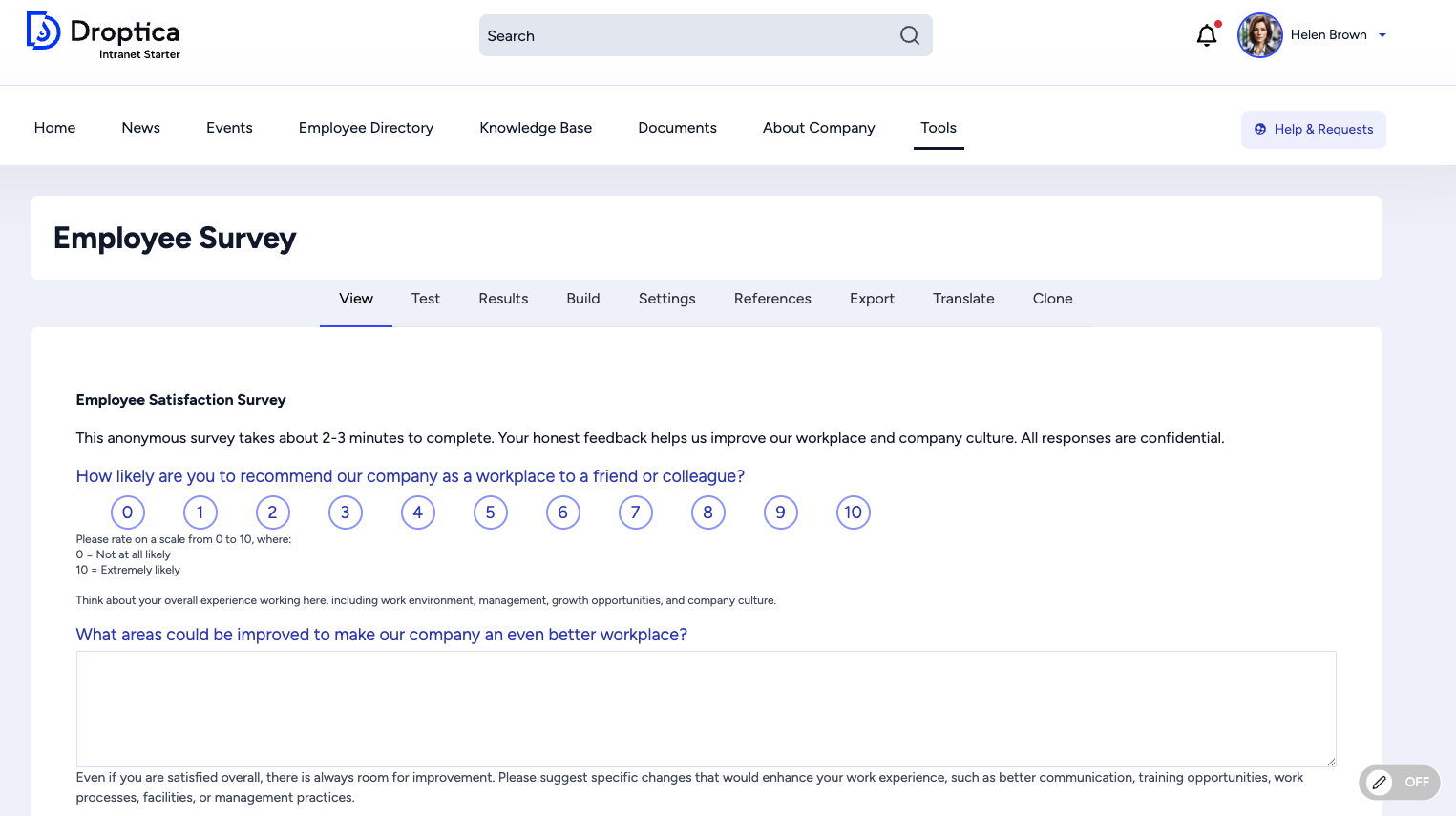
Creating additional forms
The system uses the Drupal Webform module, which allows you to build additional forms without any programming knowledge. In the Structure > Webforms section, you can add various types of fields: text fields, drop-down lists, checkboxes, attachments, and customize them to suit the specific needs of your organization.
All forms are integrated with the intranet portal, so employees fill them out in the same place where they check news and documents every day. This integration significantly increases the response rate compared to external survey tools or links sent by email. The system automatically collects all data in one place, eliminating the need for HR managers to jump between different platforms.
2. Employee profile and self-service
The HR department in companies employing hundreds or thousands of employees constantly receives inquiries such as “I need contact details for someone from the marketing department in Warsaw” or “who is responsible for data analytics?”. Employees are unable to remember the names and roles of everyone in the organization, so they turn to HR for help in finding the right contacts.
An employee directory in a modern intranet system is a solution that relieves the HR department of routine contact inquiries and makes it easier for employees to find the right people in the organization on their own. The system allows you to search by various criteria and provides easy access to current contact information.
Benefits of an employee directory:
- Reduction in inquiries to HR. Instead of calling HR to ask “who is in charge of marketing in the Krakow branch?”, employees can search for the right people in the directory themselves.
- Reduced data update workload. Depending on the system configuration, employees can update their contact details themselves, eliminating the need for manual editing by the HR department.
- Support for HR processes. The directory facilitates internal recruitment, training planning, and the identification of experts in specific areas for interdepartmental projects.
- Better management of the organizational structure. HR has a clear picture of the company's structure and supervisor-subordinate relationships and can more easily manage organizational changes.
Profile data management
The approach to profile editing may vary depending on the needs of the organization.
Full employee self-service
Employees can update their contact details, photos, and competency descriptions themselves. This solution maximally relieves the HR department of routine data update tasks.
Controlled permission management
The administrator can precisely specify which fields each employee can edit and which remain the responsibility of HR. In some organizations, profiles are downloaded from external systems (e.g., Active Directory), and users can only edit selected elements—for example, a photo or competency description—but cannot modify their position, department, or office assignment. This ensures organizational data consistency and HR control over key information.
Example from Open Intranet
In Open Intranet, each employee receives an editable profile with the ability to update key information. The system allows you to:
- edit contact details - phone number, email address, home address,
- add a profile photo - facilitates identification, especially in large organizations,
- add a job description and competencies - employees can present their skills and areas of interest,
- adding information about experience - useful for internal recruitment and interdepartmental projects,
- add additional information tailored to the specifics of the company. Depending on the needs of the organization, fields such as certificates and licenses, a list of clients with whom the person has worked, a list of technologies or equipment (e.g., in a construction company) that the employee is familiar with, and standard working hours (if the company has multiple shifts or flexible working hours).
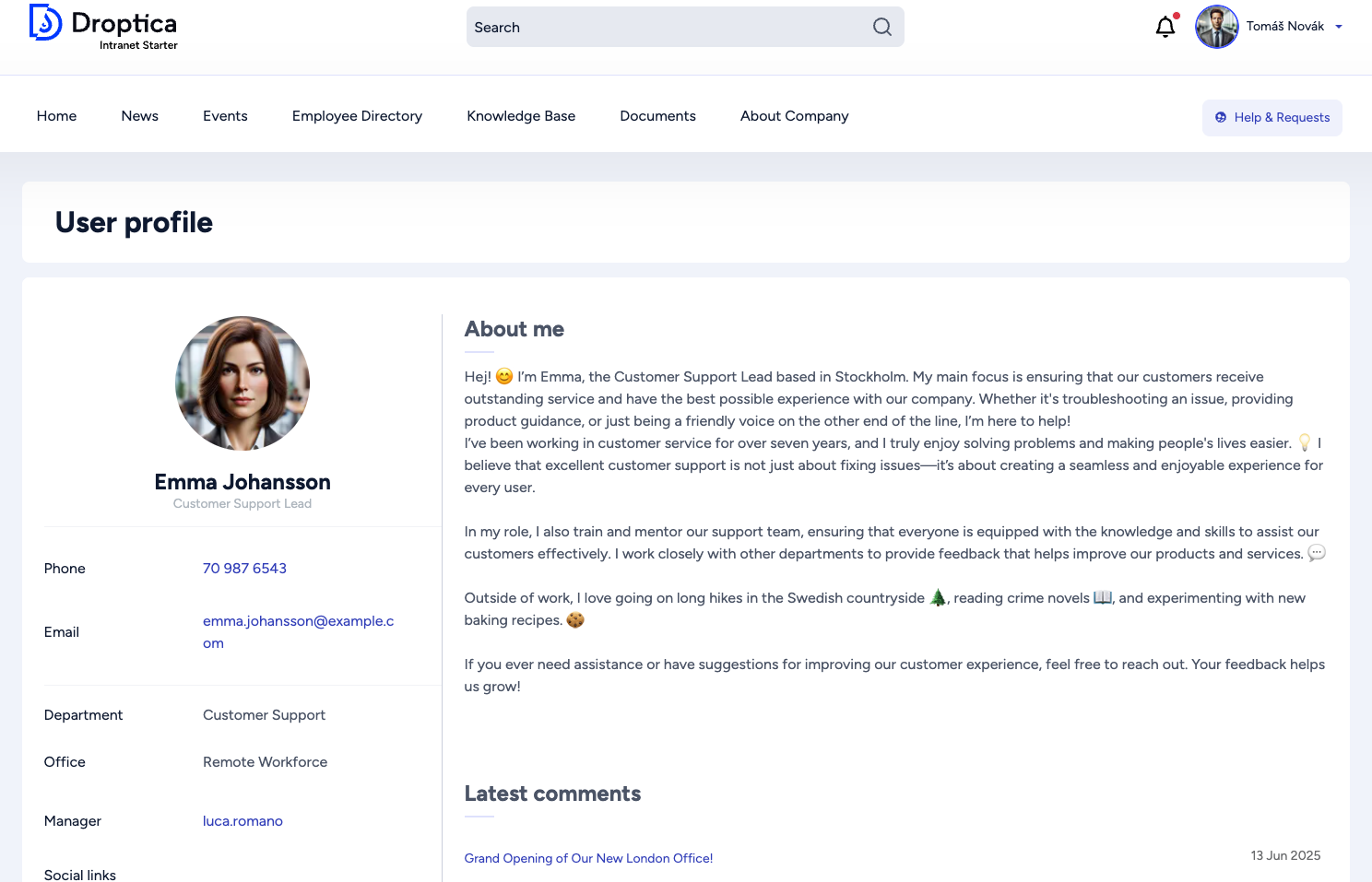
Flexible permissions
The company intranet administrator can precisely specify which fields can be edited by employees and which can only be changed by HR personnel. You can also set different visibility levels - some information can be available to the entire company, while other information can only be seen by supervisors.
Organizational structure
The system automatically assigns existing employees to departments and teams, showing supervisor-subordinate relationships. This makes it easy for everyone to find the right contact person in the organization, which is especially useful for new hires.
3. Leave and absence management
Leave management is one of the most time-consuming processes in the human resources department. Paper applications that need to be physically submitted to a supervisor, emails requesting approval, manually checking available leave days, and keeping calendars in Excel—all of this generates chaos and errors. Employees don't know if their request has reached the right person, supervisors lose documents, and HR managers spend hours tracking the status of individual requests.
An electronic leave management system in the HR intranet software automates the entire process from submission to calendar update. The employee fills out an online form, the system automatically forwards it to the appropriate supervisor, and once approved, updates the absence calendar available to the entire organization.
Key benefits of electronic leave management:
- Automatic approval workflow. The system knows that a leave request must first go to the immediate supervisor, then to the department manager, and finally to HR managers. Each person in the approval chain receives an automatic email notification with the option to accept or reject the request directly from the message.
- Transparency of the process. Employees can check the status of their request at any time: whether it is awaiting approval by their supervisor, has been approved, or requires additional information.
- Automatic availability check. The HR intranet software can check whether the employee has enough vacation days, whether their request conflicts with the vacations of key team members, or whether it falls during a company closure period. Incorrect requests are automatically rejected with an explanation of the reason.
Different types of absences
The system can handle not only vacation leave, but also sick leave, leave on demand, business trips, and special leave—each with its own approval rules.
Replacements
When submitting a request, an employee can indicate a replacement and provide them with key information about their current tasks.
Notifications for the team
The system can automatically notify team members of planned absences so that they can plan their work accordingly.
Reports and statistics
HR team receives ready-made reports on vacation usage, average request approval times, and the most popular vacation periods, which facilitates planning and decision-making.
4. Internal recruitment
External recruitment is a costly and time-consuming process—advertisements on job portals, screening CVs, and interviews with candidates who are often unfamiliar with the company culture. Meanwhile, there may already be people with the right skills working in the company who would like to develop their careers in a new direction. The problem is that many employees are often unaware of available promotion opportunities, and HR does not have a complete picture of the talent within the organization.
Internal recruitment via the HR intranet portal is a way to leverage the potential of current employees and build career paths within the organization. The system allows you to publish job offers available only to the current team, collect applications, and conduct the entire recruitment process within the company.
Benefits of internal recruitment:
- Lower recruitment costs. No fees for job ads on job portals, less time spent screening external candidates' resumes, faster decision-making process thanks to familiarity with the candidates.
- Better cultural fit. Current employees already know the company values, way of working, and expectations, so the risk of cultural mismatch is much lower than with external candidates.
- Motivation and retention. The possibility of internal promotion increases employee engagement and reduces turnover. People see prospects for growth within the company and are more likely to stay longer.
- Faster onboarding. An employee who already knows the company, procedures, and team needs significantly less time to reach full productivity in a new position.
- Building career paths. Regular internal recruitment shows employees possible directions for development and motivates them to improve their qualifications.
How does internal recruitment work on the corporate intranet?
The internal recruitment process on the HR intranet portal begins with the creation of a dedicated job offers section accessible only to logged-in employees. Here, HR managers publish current opportunities for promotion and job changes that are not visible to people outside the organization. Employees can browse available offers at their convenience, without pressure from their superiors.
When an employee finds an offer that interests them, they can apply directly through the HR intranet software, attaching their current resume and cover letter. The system automatically notifies the HR team of new applications and allows candidates to track the status of their application—whether it has been accepted for consideration, when interviews are scheduled, or what stage of the selection process it is at.
The ability to maintain a talent database is particularly valuable—HR managers can collect information about employees interested in changing positions or developing in specific directions. When a suitable offer arises, the system can automatically notify potential candidates, even if they are not currently browsing job offers. This allows for proactive talent management within the organization.
5. HR knowledge base
Every day, the human resources department answers the same questions: "Where can I find the work regulations?", "How do I submit a reimbursement request?", "When are paydays?", "What are my vacation rights?". Employees bombard the HR team with emails and phone calls looking for information that should be easily accessible. Meanwhile, HR policies, regulations, procedures, and forms are scattered across various network folders, old emails, or physical files.
A central HR knowledge base on the intranet site is a solution that eliminates information chaos and relieves the human resources department of repetitive queries. All important documents, procedures, and answers to frequently asked questions are in one place, accessible 24/7 to all employees.
Benefits of a central HR knowledge base:
- Elimination of repetitive questions. Instead of answering the same questions dozens of times, HR can create a complete answer once and make it available in the knowledge base. Employees will find the information they need themselves without having to contact the HR department.
- Always up-to-date information. When work regulations or vacation procedures change, all you need to do is update one document in the HR intranet software. All employees automatically have access to the latest version, without the risk of using outdated information.
- Easy search. Instead of searching through folders and emails, employees can enter a keyword and immediately find the document or procedure they need. The system can suggest related content and the most frequently searched information.
- Access control. Some HR information is confidential or only relevant to specific groups of employees. The intranet system allows you to precisely manage who has access to which documents—from publicly available regulations to confidential HR procedures.
- Change history and versioning. The system automatically stores the history of all changes to documents, which is particularly important for HR policies that must comply with labor law.
Documents and procedures section
Work regulations, vacation procedures, business trip rules, security policies—all organized by category and easy to find.
Forms and applications
A central location for all HR forms—from vacation requests to training applications. Employees know where to look and can be sure they are using the latest versions.
Frequently asked questions (FAQ)
Answers to common employee questions, organized by topic. Instead of calling HR managers, employees can check the FAQ for answers.
News and HR announcements
A dedicated section for HR announcements—changes in employee benefits, new procedures, application deadlines, and training information.
Guides and instructions
Step-by-step instructions for the most important HR processes—how to submit a vacation request, how to report a business trip, and how to take advantage of benefits.
Example from Open Intranet
Open Intranet offers a knowledge base that allows you to:
- Classify documents by category and tags. HR documents can be organized by department (recruitment, payroll, benefits) and tags (urgent, new procedures, forms). This makes it easier for employees to quickly find the information they need.
- Control access to specific files. The administrator can precisely determine who has access to which documents. General regulations can be available to everyone, while confidential HR procedures can be available only to selected individuals.
- Document versioning and change history. The system automatically stores all versions of documents, which is crucial for HR policies that must comply with legal regulations. You can easily check when and by whom a change was made.
- Suggested related content - when an employee reads about the vacation procedure, the system can automatically suggest related documents such as a vacation request form or work time regulations.
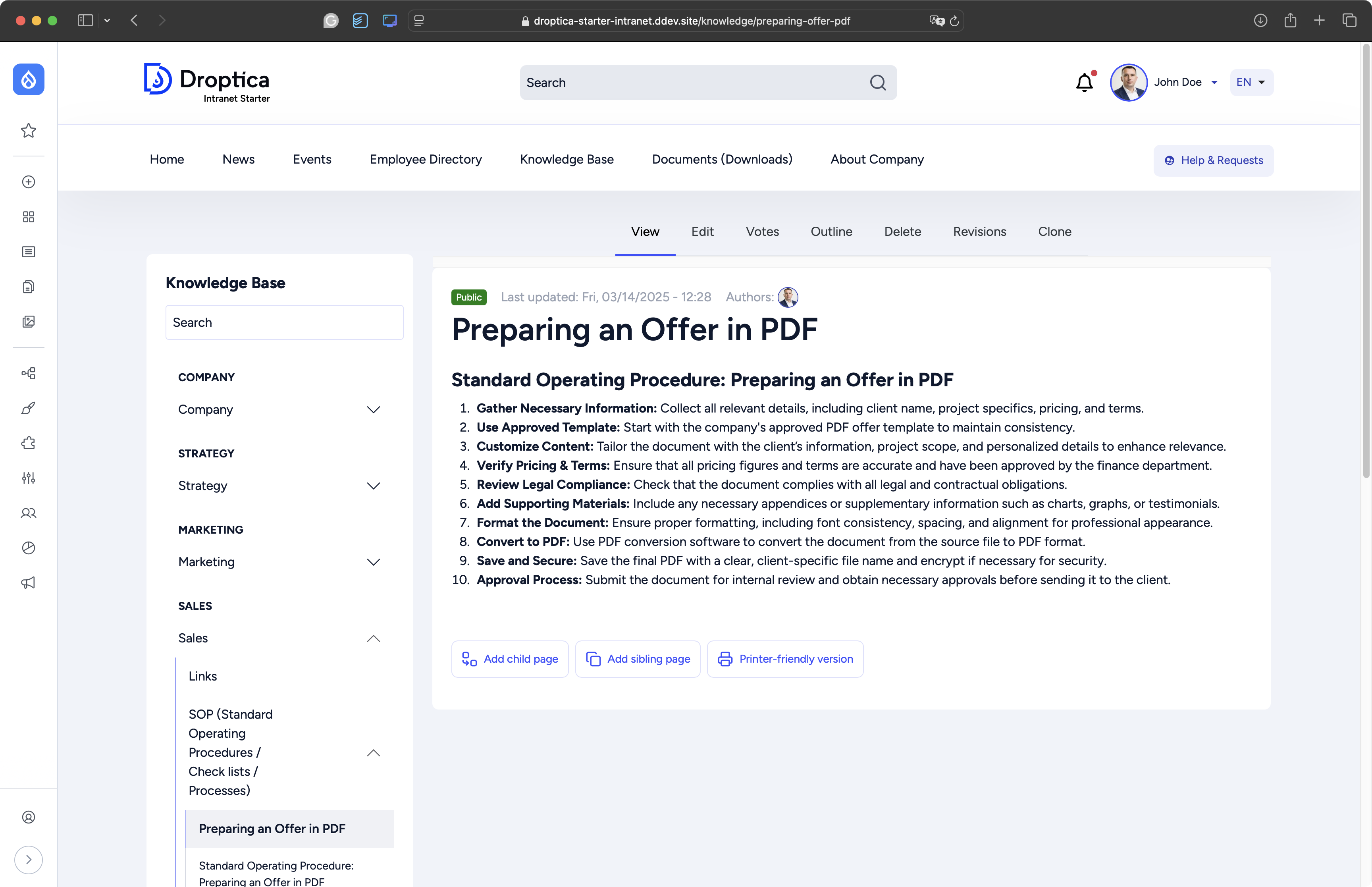
6. Onboarding new employees
A new employee's first days at a company are a crucial moment that can determine their long-term commitment and success in the organization. A well-organized onboarding process influences whether a new hire will quickly feel part of the team and reach full productivity. Unfortunately, in many companies, onboarding new hires is a chaotic process—showing them around the office, introducing them to dozens of people whose names are impossible to remember, and wading through a pile of documents that they will never have access to again.
Systematic onboarding on the company intranet site is a way to create a positive first impression and effectively introduce a new employee to the company culture. The HR intranet system allows you to organize the entire onboarding process in one place, accessible 24/7, where the new employee can get to know the company at their own pace and complete the necessary formalities.
Benefits of organized onboarding:
- A structured onboarding process. Instead of a chaotic first day, new employees receive a clear action plan with specific tasks to be completed by specific deadlines. They know what is expected of them and can track their progress.
- Information is available 24/7. Training materials, rules, and procedures are available at any time. New hires can refer to them repeatedly without having to ask their colleagues to re-explain basic issues.
- Reduced stress and uncertainty. Clear instructions and a step-by-step guide (that acts as an employee handbook) eliminate the uncertainty typical of the first days in a new job. Employees know what to do and where to look for help.
- Team time savings. Instead of repeatedly explaining the same things to different new hires, the team can focus on substantive support and integration.
- Process consistency. Every new employee goes through the same, proven onboarding process, ensuring that no one misses important information.
Welcome page for new employees
A dedicated section with a warm welcome, basic information about the company, and a guide to the first few days. This is where new hires will find everything they need to get started.
Interactive checklist
A detailed checklist of tasks to complete in the first days, weeks, and months of employment. Each task can be marked as completed, giving a sense of progress and control over the process.
Training and introductory materials
Videos, presentations, documents, and guides are available in one digital workplace. New employees can return to them at any time and learn at their own pace.
Team and organizational structure presentation
Employee directories with their roles, competencies, and photos make it easier to remember names and functions in the company. This is especially useful in large organizations.
Forms and formalities
All the necessary documents to fill out in one place—from contracts to data processing consents. The company intranet site can remind you of deadlines and track which formalities have already been completed.
Feedback survey
After the trial period, you can ask for employee feedback on the onboarding process, which allows for continuous improvement of the onboarding system.
Example from Open Intranet
Open Intranet offers all the tools you need to create a comprehensive onboarding process. New employees can access a dedicated section with a step-by-step guide, where they will find training materials, introductory videos, and an interactive checklist of tasks to complete. The system allows for automatic notifications about new people in the company, which facilitates team integration. The employee directory with roles and competencies helps new employees quickly understand the structure of the organization and find the right contact persons.
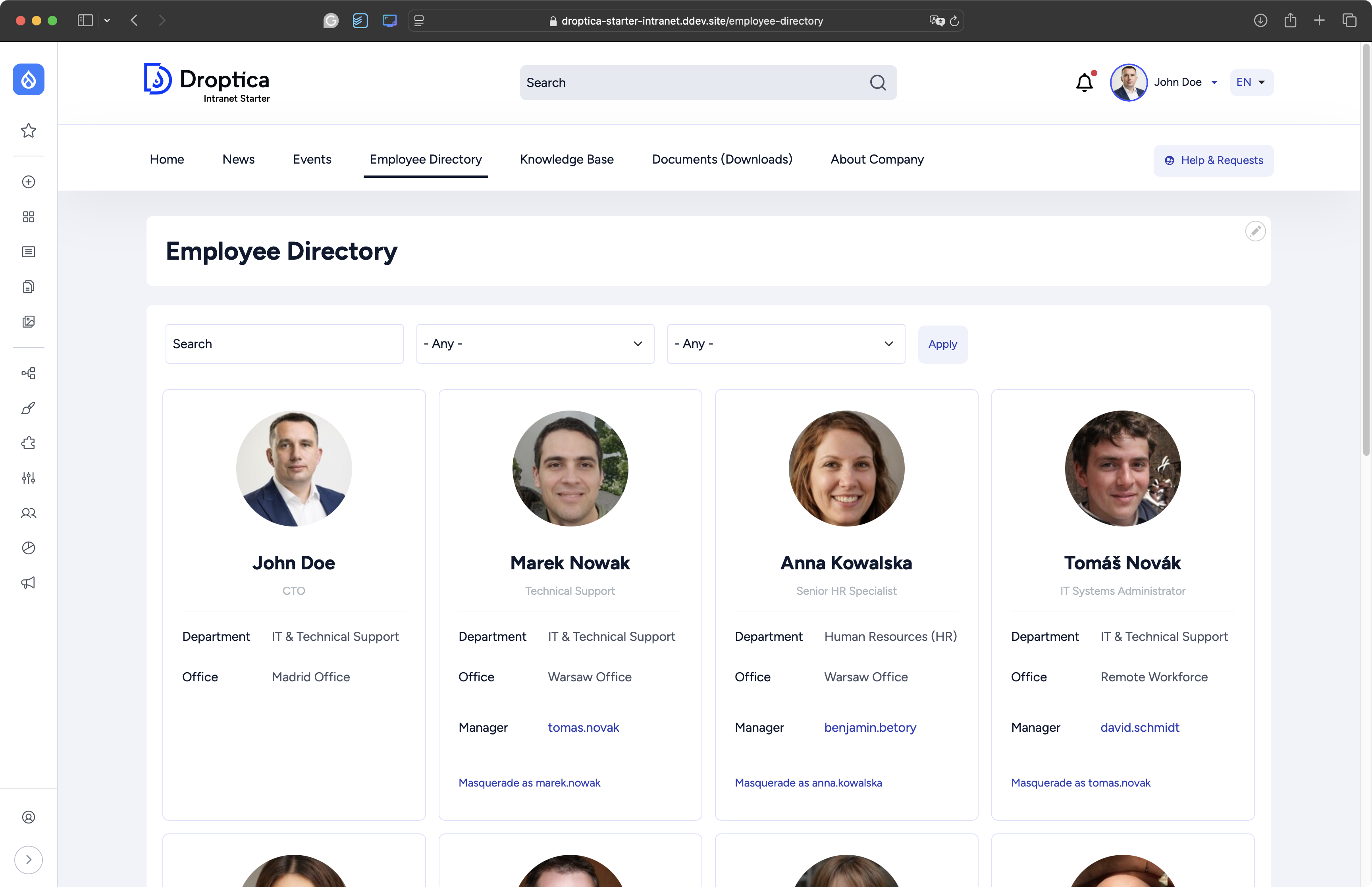
Thanks to the internal forms feature, Open Intranet also allows you to collect employee feedback about the onboarding process, enabling you to continuously improve the onboarding system and adapt it to the actual needs of the organization. Effective onboarding is an investment that pays for itself many times over through higher employee retention, faster achievement of full productivity, and better employee engagement.
7. Employee development and training
Planning employee training sessions in the traditional way is often a shot in the dark. The human resources department organizes training based on general assumptions or suggestions from management without having a complete picture of the actual needs of employees. The result? Low attendance, poor engagement, and a wasted training budget on courses that do not meet the team's actual needs.
An employee development management system on the HR intranet portal allows you to collect specific training needs directly from the people concerned and plan your development budget based on actual demand. Instead of guessing, HR managers receive precise data on what skills employees want to develop and in which areas they see the greatest needs.
Benefits of systematic employee development management:
- Budget planning based on actual needs. Instead of randomly allocating funds for training, HR can analyze employee requests and identify the most popular areas for development. This allows you to negotiate better prices for group training and avoid investing in courses that no one will sign up for.
- Increased engagement in training. When employees themselves report their training needs, they are much more motivated to participate. This is not a top-down course, but a response to their own development needs.
- Identification of development trends. The company intranet solution allows for the analysis of which competencies are most frequently reported in individual departments. HR managers can identify growing needs in new technologies or work methodologies at an early stage.
- Fair access to development. A transparent system for reporting needs eliminates situations where only selected individuals learn about training opportunities. Every employee has equal access to information about development opportunities.
Training needs reporting forms
Employees can report specific areas in which they want to develop, along with a justification of the need and their preferred date. The HR intranet system can categorize requests by department, type of training, or urgency.
Database of available training
A central location with information about available courses, internal training, and external development opportunities. Employees can browse the offerings and apply for training that interests them.
Register of completed training
The HR intranet software stores the history of all training completed by each employee, which facilitates career path planning and the identification of experts in specific areas.
Certificate and license management
Automatic reminders of upcoming expiration dates for certificates or licenses, which is particularly important in industries that require regular renewal of qualifications.
Training effectiveness assessment
Post-training feedback surveys allow you to evaluate the quality of courses and providers, which helps you make better decisions about future investments in development.
Example from Open Intranet
Open Intranet allows you to install Courses, a comprehensive learning management system (LMS) for organizational training and course delivery. After installing the module, the system creates content types for courses and lessons with fields for course structure, lesson content, and progress tracking.
After installing the module, a sample training course, “Password Security,” is available to demonstrate the system's capabilities. Administrators can easily add their own training courses tailored to their organization's needs.
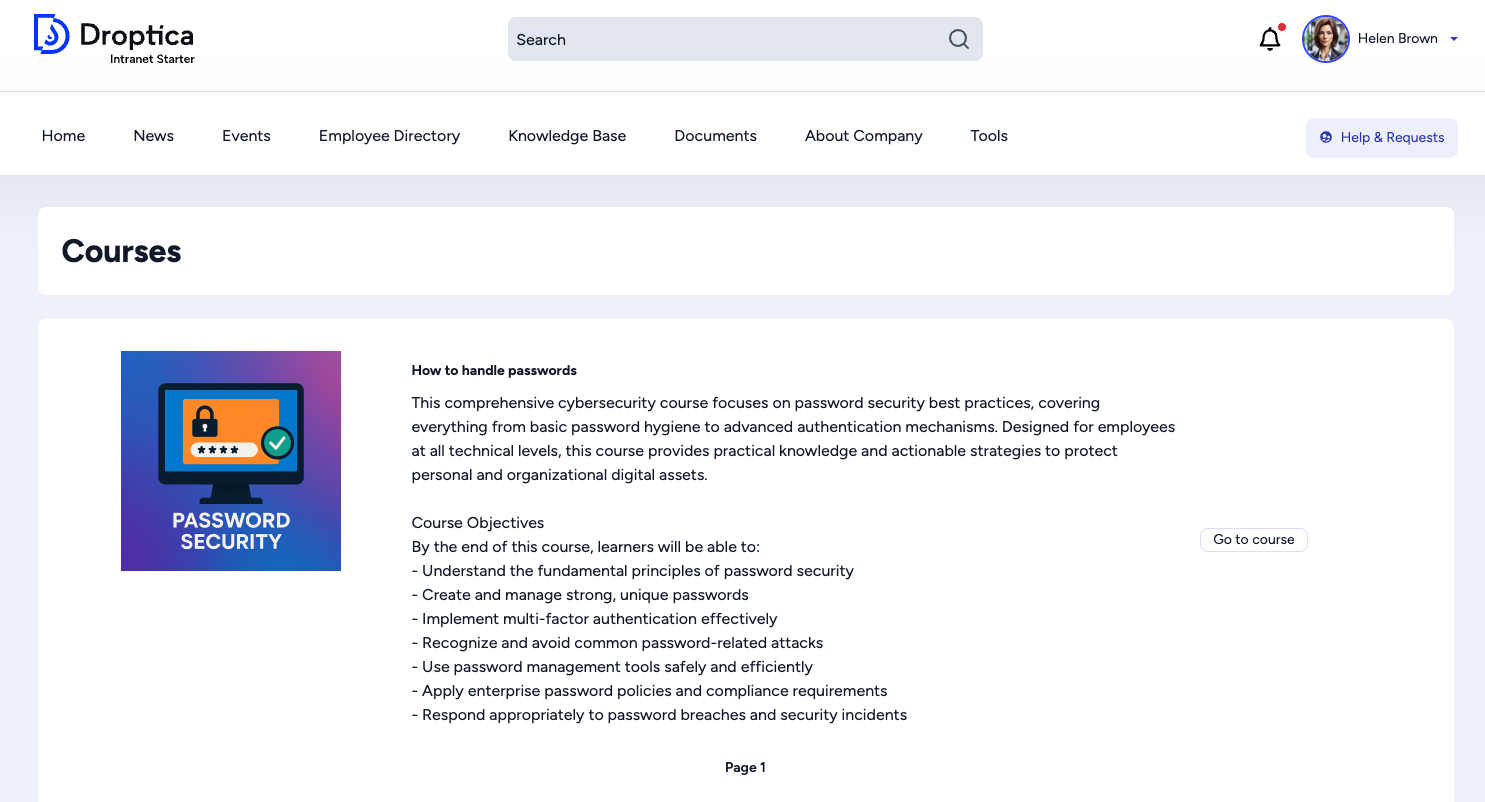
Summary - benefits of a company intranet for HR
The modern intranet solutions transform the work of the human resources department from reactive administration to strategic human resources management. Automation of routine processes, centralization of information, and employee self-service are the foundations of this change.
Key benefits:
- Saving time and resources. Electronic forms, automatic approval workflows, and a knowledge base eliminate dozens of hours per week spent manually processing requests and answering repetitive questions. HR managers can focus on strategic tasks instead of administration.
- Better data-driven decisions. The system provides specific information about employee needs, vacation trends, and team satisfaction levels. This allows you to plan actions based on facts rather than intuition.
- Increased employee engagement. Transparent processes, easy access to information, and the ability to manage matters independently build trust and team satisfaction. Employees feel more involved in the organization's life.
- Professionalization of processes. Standard procedures and digital documentation increase the level of professionalism of the human resources department, which translates into the company's credibility in the eyes of employees and candidates.
Practical implementation
Solutions such as Open Intranet show that advanced HR functions do not require huge budgets or long intranet implementations. Software based on proven technologies can be adapted to the needs of any organization, from small businesses to large corporations.
The key to success is the gradual implementation of functionalities - starting with basic processes such as leave management, and then expanding the system to other areas as the team becomes familiar with the new tools. We can explain this process to you in detail and show you the functionalities of Open Intranet for HR departments during a free consultation.
***
Updated article dated 10/09/2020


